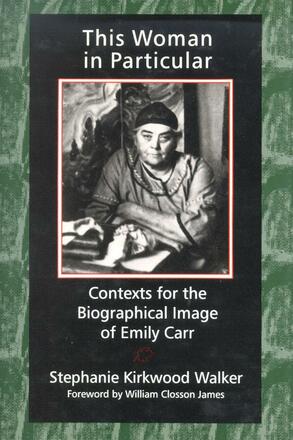
Description
What happens when an individual becomes the subject of many and divergent portraits?
“Biography,” says Stephanie Kirkwood Walker, “is a deceptive genre. Positioned between fact and fiction and elusive in its purposes, biography displays an individual life, an existence patterned by conventions that have also shaped the reader’s experience.” In This Woman in Particular, Walker explores versions of Emily Carr’s life that have appeared over the last half-century.
Walker contends that the biographical image of Emily Carr that emerges from an accumulation of biographies, films, plays and poetry as well as her own autobiographical writing establishes an elaborated cultural artefact — an “image” that is bound by its very nature to remain forever incomplete and always elusive. She demonstrates how changes in Carr’s biographical image parallel the maturing of Canadian biographical writing, reflecting attitudes toward women artists and the shifting balance between religion, secular attitudes and contemporary spirituality. And she concludes that biography plays a crucial role in all our lives in initiating and sustaining debate on vital personal and collective concerns.
Reviews
``[This Women in Particular]...is a superlative and painstaking contribution to the literary and biographical canon regarding the work and life of Emily Carr. It is also a unique and valuable addition to any serious discussion of the nature of biography, biographical research, and biographical literature.''
- The Midwest Book Review
``[An] excellent and important book.... Walker's contextualization is impressive. In very effective and learned ways, she elaborates cultural, social, and art history, biographical and feminist theory, bringing each to bear on the construction of Carr's biographical image.... Walker is especially effective in tracing the ways Carr's avowed religiosity -- especially seen in her readings and wonderings over Theosophy under the influence of Lawren Harris -- becomes a malleable spirituality in the hands of Carr's biographers....Walker is at her very best, for she traces carefully and very adeptly contextualizes the construction of Emily Carr's image from its beginnings in the early decades of the century through the appropriation controversies of the mid-1990's....she has made a significant contribution to Canadian cultural studies with This Women in Particular, a book that needs to be read, and referred to often, by anyone interested in Emily Carr or the writing artist's numerous -- and still numinous -- cultural moments.''
- Robert Thacker
``Walker's book...offers apt observations, particularly about the spiritual dimensions of Carr's image....''
- Susan Crean
``Stephanie Kirkwood Walker's thoughtful and meticulously researched analysis of the writings about Emily Carr (Carr's own writings included) serves to relocate a discussion of Carr, thereby challenging the closure of the autobiographical text and shattering the boundaries of the absolutist empiricism which has threatened to turn Carr and her words to stone....Walker is not an art historian and does not attempt to make critical analyses of Carr's paintings; rather she approaches Carr from the discipline of religious studies and because of this offers the art historical reader an important perspective on the production and consumption of Carr's art.... [A]rt historians will be well-served by her sometimes tentative but always lucid examination of the spiritual, particularly her placement of Carr into a tradition of writing about female mystics which draws upon literature with which few art historians will be familiar. Most important, Walker signals directions: her listing of `loci of late-twentieth-century concern,' specifically `[w]oman, nature power, space, health, cities' (p. 138), highlights issues that will, one hopes, be taken further.''
- The Journal of Canadian Art History